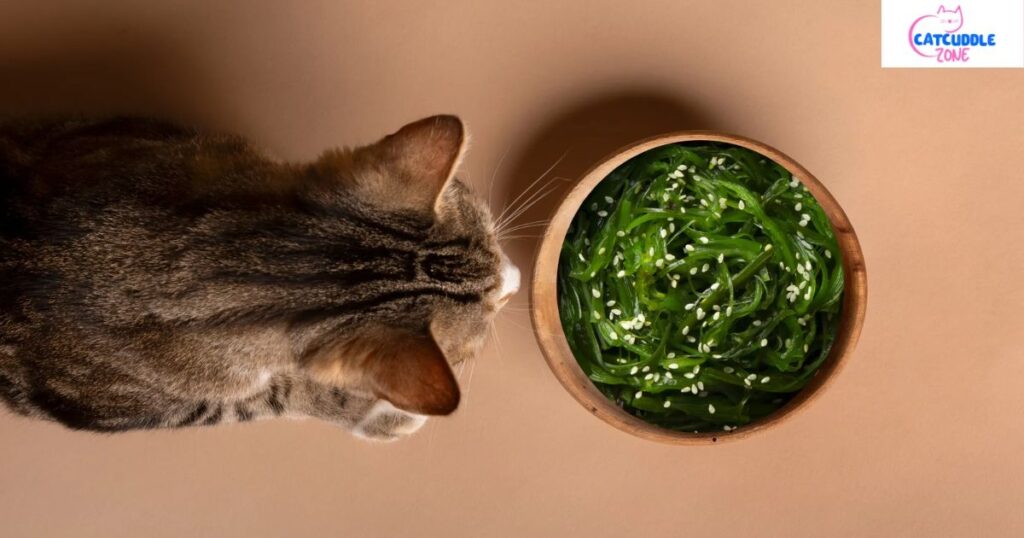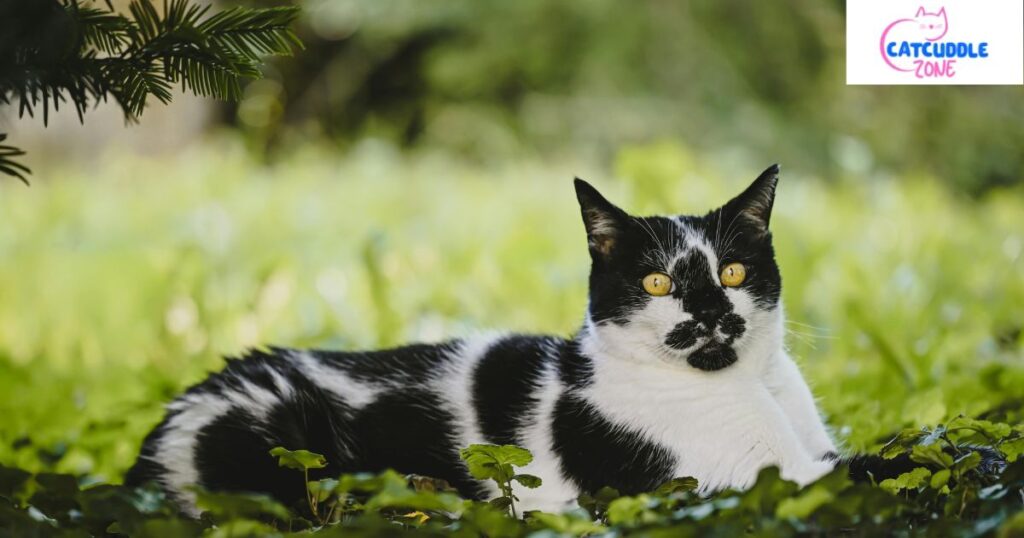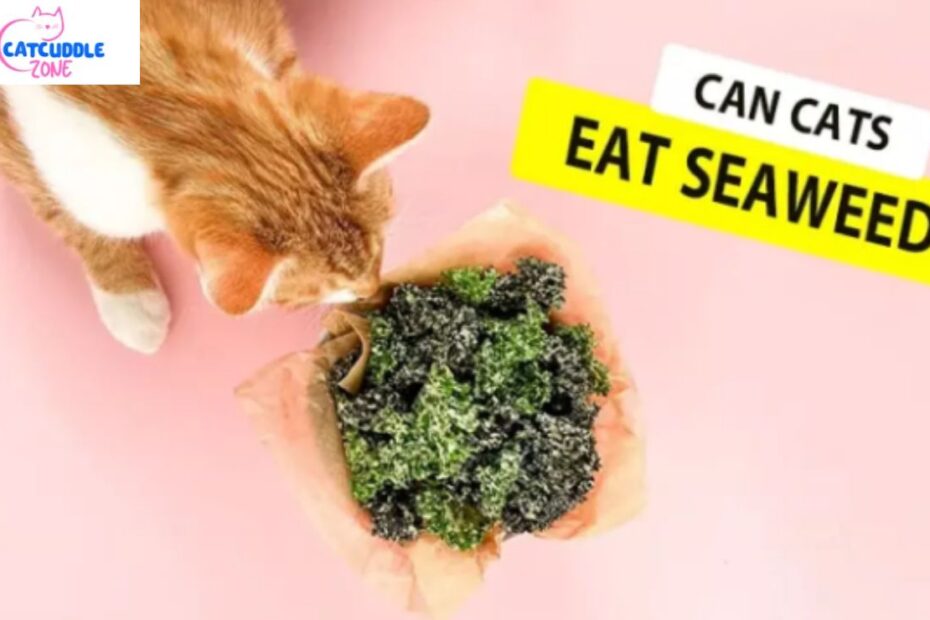If you’ve ever enjoyed sushi or crunchy snacks, you may have wondered, can cats eat seaweed? Seaweed isn’t just for humans—it can also play a role in feline nutrition when served safely. Some owners use seaweed for cats as a natural supplement because it’s packed with minerals, fiber, and healthy fats.
You might even find seaweed treats for cats or commercial foods enhanced with this marine plant. However, moderation is essential since too much can cause seaweed and cat thyroid issues. When given properly, seaweed may support seaweed for digestion in cats and even improve skin and coat health.
Is Seaweed Safe for Cats to Eat?
Cats can safely consume small portions of cat safe seaweed. It is rich in nutrients and has been incorporating some pet food over the years. Nevertheless, excess may lead to complications, including the dysfunction of the thyroid. The most important thing is moderation in consumption of seaweeds and you should just feed your cat in bits.
Not every marine plant used as a pet is safe. Cats must never consume seaweed products containing salt, spices or oils. Cats can get their stomach upset when they are given snack sheets that have been dried, such as asking them, can cats eat nori. Plain, unseasoned varieties such as Acadian sea kelp, Dulse, Irish moss, Nori, Kombu, Wakame or Sea lettuce are always preferable.
Nutritional Value of Seaweed for Cats
Seaweed is not merely marine plant life. It includes Omega-3 fatty acids, Iodine, Antioxidants and Prebiotics that would help maintain the health of a cat. They are natural cat nutrition supplements, which are common in seaweed supplements to cats or cat functional foods.
Omega-3 Fatty Acids
Among the most popular benefits of seaweed to pets, we should mention its ability to provide omega-3 to cats. These healthy fats make the coat shine and maintain the good health of skin. They are also capable of causing a decrease in inflammation, which is applicable in old cats that have joint stiffness.
Iodine Content
Iodine in seaweed and cats is a tricky balance. A small amount supports thyroid hormones, but excess iodine can lead to hyperthyroidism in cats. That’s why vets often say only a pinch is safe and why the safe daily amount (0.3g/day) is recommended.
Antioxidants
Seaweed works as a natural protector. It contains antioxidants that help with aging protection. When cats eat seaweed in small amounts, they may stay healthier as their cells repair faster. Many people call seaweed an antioxidant for cats.
Fiber and Protein
Seaweed is also a digestible source of fiber and protein. It supports gut bacteria balance and helps cats process food better. Many owners use seaweed for digestion in cats, especially when they notice hairballs or mild constipation.
Health Benefits of Seaweed for Cats
The biggest advantage of seaweed for cats is its overall impact on wellness. Cats who eat safe amounts may enjoy fewer stomach problems and better-looking coats. Seaweed for cat skin health is real because of the fatty acids and minerals that keep the coat smooth.
Other benefits include better dental health. The Bacillus licheniformis enzyme in seaweed helps reduce plaque. Some companies even sell seaweed dental chews for cats for this reason. Owners also notice that cats stay active and appear younger thanks to the support against free radical damage.

How Much Seaweed Can Cats Safely Eat?
Cats are not supposed to consume a lot of seaweed. Researchers suggest the safe dose (0.3g/day) as a benchmark. This amounts to a sprinkle on their normal meal. Never feed them fast, cats have delicate stomachs.
It can be problematic to feed more. Cats are obligate carnivores and hence the seaweed treats to cats must be a bonus rather than a food. Consult your vet in case of doubts on whether to add or not to add seaweed to the diet.
Risks and Side Effects of Seaweed in a Cat’s Diet
Cat thyroid and seaweed is one of the major threats. Excessive consumption of iodine leads to hyperthyroidism among cats. This disease results in loss of weight, restlessness, and poor quality of coat. The amount that is given should always be monitored by the owners.
Other dangers are vomiting following seaweed, diarrhea and stomach pain. Cats cannot also consume some of the dried products that contain high sodium. In case you wish to include this element of a holistic cat diet, you should always purchase plain ones without any salt content, and that are approved by the veterinarians.
Can Seaweed Help With Digestion and Hairballs?
Yes, seaweed is a sort of natural helper. It has prebiotics to the cats which feed on the good bacteria in the gut. This enhances the digestion process and allows the cats to digest the nutrients in the food. The owners can use seaweed to digest cats when they have problems with constipation.
SOF also aids in the passage of fur swallowed by people into the intestines due to the fiber contained in the seaweed. This results in fewer hairballs and the reduction of stress on your cat. Nevertheless, it should be insignificant, as it may even make their stomach sick.
Seaweed in Commercial Cat Food vs. Homemade Treats
Some USA pet food companies add seaweed in cat food because it supports health. These formulas balance nutrients so cats can enjoy the benefits without the risks of excess iodine. Products with Acadian sea kelp or Irish moss are especially popular.
Homemade seaweed snacks can be risky. Many people ask, can cats eat nori sheets? While they can, these often contain too much salt. For safety, rely on seaweed supplements for cats that are made for pets, not human snacks.
When to Avoid Giving Seaweed to Your Cat
Certain cats should never have seaweed. Those with hyperthyroidism in cats or kidney disease are at higher risk. Cats with sensitive digestion may also react badly to even small amounts.
Pregnant or nursing cats should avoid seaweed too. Their hormone balance is delicate, and the risk of thyroid function impairment is too high. In such cases, safer foods are better.

What to Do if Your Cat Eats Too Much Seaweed
If your cat eats a large amount, watch closely. Signs like vomiting after seaweed, restlessness, or unusual thirst could mean too much iodine. Call your vet immediately if symptoms don’t stop.
At home, remove any remaining seaweed and offer fresh water. Don’t panic, but don’t wait too long either. Quick action keeps your cat safe when too much of even a safe seaweed for cats is eaten.
Safer Alternatives and Vet-Recommended Supplements
Not all cats should eat seaweed. If yours falls in that group, there are safe choices. Vets often suggest pumpkin puree or psyllium husk as alternatives for fiber. For healthy fats, fish oil is safer than seaweed.
The market in the USA also has many cat nutrition supplements. These include functional foods for cats with vitamins, minerals, and probiotics. They give the same support as seaweed without the danger of excess iodine.
Conclusion
So, can cats eat seaweed? Yes, but never too much. It contains highly nutritious elements such as Omega-3 fatty acids, antioxidants, and prebiotics that enhance the skin condition, digestion, and even dental condition.
Still, overfeeding may cause seaweed and cat thyroid issues. Stick to moderation, rely on seaweed treats for cats made for pets, and consult your vet before adding this marine plant for pets to the diet.
📊 Table: Safe vs Unsafe Seaweed for Cats
| Safe Seaweed Types | Unsafe Forms |
| Acadian sea kelp | Seaweed with salt |
| Dulse | Seasoned nori snacks |
| Irish moss | Seaweed in soups/sauces |
| Nori (plain) | Oily roasted seaweed |
| Kombu | Seaweed chips |
| Wakame | Mixed seaweed salads |
| Sea lettuce | Pickled seaweed |
FAQs
Why does my cat like dried seaweed?
Cats often enjoy dried seaweed because of its salty, umami flavor and crunchy texture.
Can pets eat seaweed?
Yes, many pets can eat plain seaweed in moderation, but flavored or salted versions are unsafe.
Is seaweed wrap good for cats?
Plain seaweed wrap can be safe in tiny amounts, but seasoned sushi wraps are not good for cats.
Which foods should cats never eat?
Cats should avoid onions, garlic, chocolate, grapes, raisins, alcohol, and caffeinated foods, as they are toxic.
